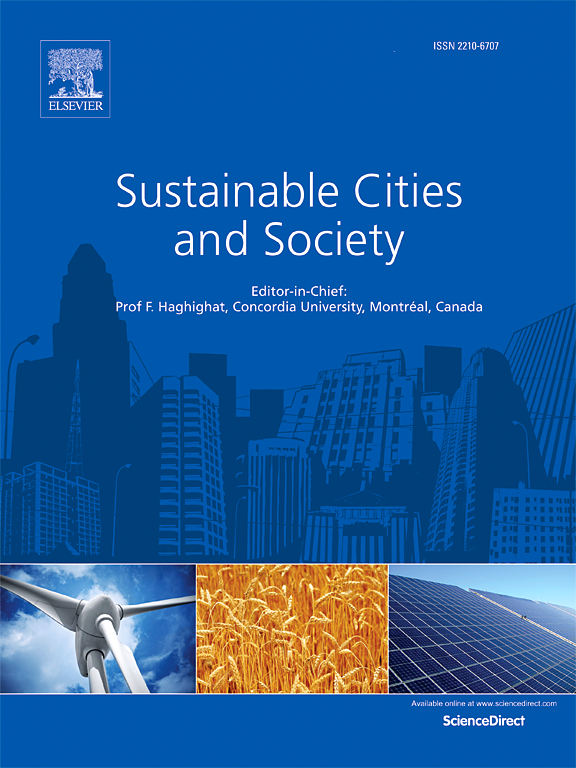Modelling urban carbon emissions for multiple sectors in high spatial resolution for achieving sustainable & net-zero cities
IF 10.5
1区 工程技术
Q1 CONSTRUCTION & BUILDING TECHNOLOGY
引用次数: 0
Abstract
Many largescale initiatives and networks have been established to support city efforts and leadership in decarbonisation. An essential first step in these initiatives is developing a Baseline Emissions Inventory (BEI) to understand drivers of current emissions and provide a benchmark that progress can be measured against. There has been increasing interest in emission inventory methods. However, previous research has focused on single sectors, has neglected emissions other than CO2, or has not followed a spatial approach. The latter is particularly important to support policy planning and decision-making. This study investigates the development of a novel BEI for a medium-sized city in Ireland to address the methodological knowledge gap in existing literature for a detailed methodology using mainly open-source and spatially resolved data for developing a multi-sectoral BEI in high spatial resolution. Greenhouse Gas (GHG) emissions including CO2, CH4, and N2O, represented as kilotonnes CO2-equivalent (ktCO2-eq), were modelled for the Residential; Transport; Commercial & Industrial; Public; Agriculture, Land Use & Fishing (ALUF); and Waste sectors. Total annual emissions were 987 ktCO2-eq, with emissions per capita of 4.7 tCO2-eq. The Residential sector accounted for 34 % of emissions followed by the Transport (29 %), Commercial & Industrial (22 %), Public (7 %), ALUF (6 %), and Waste (2 %) sectors. The fine-resolution spatial outputs facilitate the investigation of socioeconomic factors alongside GHG emissions helping to elucidate local drivers and produce equitable mitigation strategies. The findings will contribute to effective policy development and the methodologies, developed in accordance with the Global Covenant of Mayors, can be replicated by cities globally.

以高空间分辨率模拟多个部门的城市碳排放,以实现可持续和净零城市
许多大规模的倡议和网络已经建立,以支持城市在去碳化方面的努力和领导力。这些倡议中至关重要的第一步是制定基线排放清单(BEI),以了解当前排放的驱动因素,并提供可衡量进展的基准。人们对排放清单方法的兴趣与日俱增。然而,以前的研究主要集中在单一部门,忽略了二氧化碳以外的排放,或者没有采用空间方法。后者对于支持政策规划和决策尤为重要。本研究调查了爱尔兰一个中等城市新型 BEI 的开发情况,以弥补现有文献在方法论知识方面的不足,即主要使用开源数据和空间分辨率数据开发高空间分辨率多部门 BEI 的详细方法。包括二氧化碳、甲烷和一氧化二氮在内的温室气体(GHG)排放量(以千吨二氧化碳当量(ktCO2-eq)表示)被模拟为住宅、交通、商业和工业、公共、农业、土地利用和渔业(ALUF)以及废弃物部门的排放量。年排放总量为 987 ktCO2-eq,人均排放量为 4.7 tCO2-eq。居民部门的排放量占 34%,其次是交通(29%)、商业及工业(22%)、公共(7%)、渔业(6%)和废物(2%)部门。高分辨率的空间输出有助于调查温室气体排放的社会经济因素,有助于阐明当地的驱动因素并制定公平的减排战略。研究结果将有助于制定有效的政策,根据《全球市长盟约》制定的方法可供全球城市效仿。
本文章由计算机程序翻译,如有差异,请以英文原文为准。
求助全文
约1分钟内获得全文
求助全文
来源期刊

Sustainable Cities and Society
Social Sciences-Geography, Planning and Development
CiteScore
22.00
自引率
13.70%
发文量
810
审稿时长
27 days
期刊介绍:
Sustainable Cities and Society (SCS) is an international journal that focuses on fundamental and applied research to promote environmentally sustainable and socially resilient cities. The journal welcomes cross-cutting, multi-disciplinary research in various areas, including:
1. Smart cities and resilient environments;
2. Alternative/clean energy sources, energy distribution, distributed energy generation, and energy demand reduction/management;
3. Monitoring and improving air quality in built environment and cities (e.g., healthy built environment and air quality management);
4. Energy efficient, low/zero carbon, and green buildings/communities;
5. Climate change mitigation and adaptation in urban environments;
6. Green infrastructure and BMPs;
7. Environmental Footprint accounting and management;
8. Urban agriculture and forestry;
9. ICT, smart grid and intelligent infrastructure;
10. Urban design/planning, regulations, legislation, certification, economics, and policy;
11. Social aspects, impacts and resiliency of cities;
12. Behavior monitoring, analysis and change within urban communities;
13. Health monitoring and improvement;
14. Nexus issues related to sustainable cities and societies;
15. Smart city governance;
16. Decision Support Systems for trade-off and uncertainty analysis for improved management of cities and society;
17. Big data, machine learning, and artificial intelligence applications and case studies;
18. Critical infrastructure protection, including security, privacy, forensics, and reliability issues of cyber-physical systems.
19. Water footprint reduction and urban water distribution, harvesting, treatment, reuse and management;
20. Waste reduction and recycling;
21. Wastewater collection, treatment and recycling;
22. Smart, clean and healthy transportation systems and infrastructure;
 求助内容:
求助内容: 应助结果提醒方式:
应助结果提醒方式:


